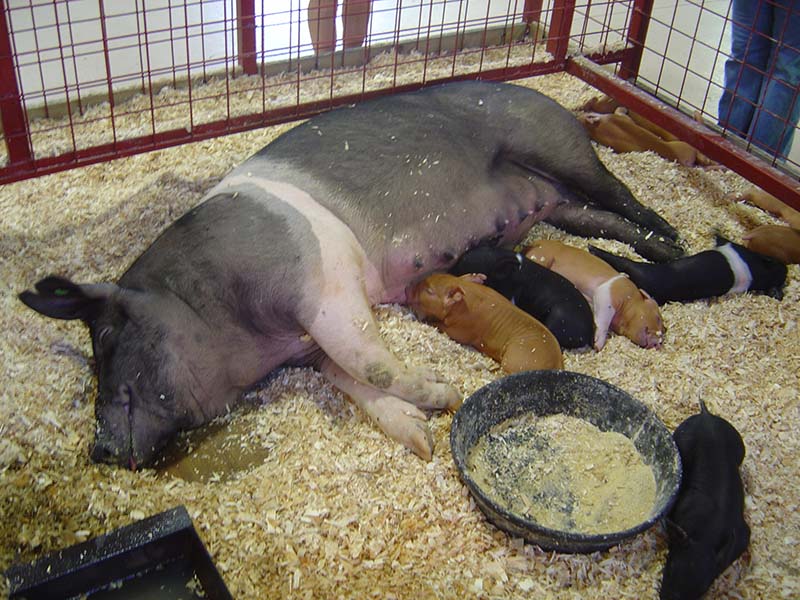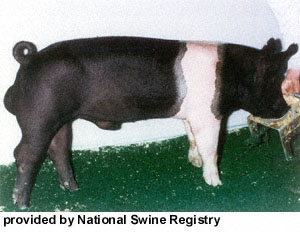Hampshire Swine
 The Hampshire breed of hogs may well be one of the oldest original early American
breeds of hogs in existence today. Although there is some doubt as to the exact origin
of the Hampshire breed, historical records indicate that Hampshires probably originated
from the "Old English Breed." This black hog with a white belt was quite numerous
in Scotland and Northumberland and other counties bordering Scotland. They were noted
and criticized for their large size, but admired for their prolificacy, hardy vigor,
foraging ability and outstanding carcass qualities.
The Hampshire breed of hogs may well be one of the oldest original early American
breeds of hogs in existence today. Although there is some doubt as to the exact origin
of the Hampshire breed, historical records indicate that Hampshires probably originated
from the "Old English Breed." This black hog with a white belt was quite numerous
in Scotland and Northumberland and other counties bordering Scotland. They were noted
and criticized for their large size, but admired for their prolificacy, hardy vigor,
foraging ability and outstanding carcass qualities.
It was from Hampshire county in England that importations were thought to be made to American between 1825 and 1835,thus the origin of the Hampshire name. Some of the early importations to American were also as the McKay hog because a man by that name was thought to have imported these hogs from England to America.
Descendants of these early importations gravitated to Kentucky where the breed had most of its early development. The common name for these hogs was the Thin Rind.
 The hogs developed in this area became quite popular because of the hardiness, vigot,
prolificacy and foraging characteristics that they possessed. Butchers from Ohio traveled
yearly into Kentucky to contract ahead for these belted hogs at a premium price. It
is said that in the establishment of the famous Smithfield Ham, only Hampshire hogs
were originally used in this product.
The hogs developed in this area became quite popular because of the hardiness, vigot,
prolificacy and foraging characteristics that they possessed. Butchers from Ohio traveled
yearly into Kentucky to contract ahead for these belted hogs at a premium price. It
is said that in the establishment of the famous Smithfield Ham, only Hampshire hogs
were originally used in this product.
These original desirable traits have always been further developed within the Hampshire breed, causing steady growth in popularity and demand.
In May of 1893, a small group of Kentucky farmers met at Erianger, Kentucky to form the first record association in order to keep pure in blood this distinctive and superior producing black hog with a white belt. The first record association was called the American Thin Rind Association.
This belted hog had various other names in those days, including McGee hog, McKay, Saddleback and Ring Middle. Because this hog was locally known by so many different names, the name was changed in 1904 to Hampshire and the record to the American Hampshire Association.
In 1907, the organization in Kentucky was discontinued and an organization was incorporated under Illinois laws. At this time, the name American Hampshire Swine Record Association was adopted. The name was shortened to Hampshire Swine Record Association in 1922, and, in 1939, the name Hampshire Swine Registry was adopted.
In a ten year period following 1910, the Hampshire breed spread rapidly across the cornbelt.
References
National Swine Registry, P.O. Box 2417, West Lafayette, IN 47906-2417 Phone: (765) 463-3594
